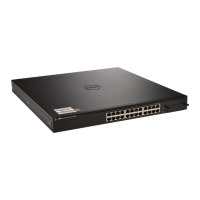Configuring Switching Information 415
•
Capability Information
— Specifies the supported and enabled capabilities that was received in MED
TLV on this port.
–
Supported Capabilities
— Specifies supported capabilities that was received in MED TLV on this
port.
–
Enabled Capabilities
— Specifies enabled capabilities that was received in MED TLV on this
port.
–
Device Class
— Specifies device class as advertised by the device remotely connected to the port.
•
Network Policy Information
—If a network policy TLV is received in the LLDP frames on this port,
the following information displays:
–
Network Application
— Specifies the type of media application that the local device advertises in
the policy. A port may receive one or more application types, which include the following types:
• unknown
•voicesignaling
•guestvoice
• guestvoicesignalling
•softphonevoice
• videoconferencing
• streammingvideo
• videosignalling
–
Vlan Id
— Specifies the VLAN ID associated with a particular policy type.
–
Priority
— Specifies the priority associated with a particular policy type.
–
DSCP
— Specifies the DSCP associated with a particular policy type.
–
Unknown Bit Status
— Specifies the unknown bit associated with a particular policy type.
–
Tagged Bit Status
— Specifies the tagged bit associated with a particular policy type.
•
Inventory
— If an inventory TLV is present in LLDP frames, the following information displays:
–
Hardware Revisions
— Specifies the hardware version of the remote device.
–
Firmware Revisions
— Specifies the firmware version of the remote device.
–
Software Revisions
— Specifies the software version of the remote device.
–
Serial Number
— Specifies the serial number of the remote device.
–
Manufacturer Name
— Specifies the manufacturer’s name of the remote device.
–
Model Name
— Specifies the model name of the remote device.
–
Asset ID
— Specifies the asset ID of the remote device.
•
Location Information
— If a location TLV is present in LLDP frames, the following information
displays:

